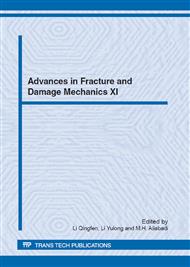p.29
p.33
p.37
p.41
p.45
p.49
p.53
p.57
p.61
Advanced Natural Stitched Composite Materials in Skin-Stiffener of Wind Turbine Blade Structures
Abstract:
In this paper the failure behaviour of natural stitched composite materials in the skin-stiffener of wind turbine blade structures are investigated. For this study, the laminated composite beams were stitched using Flax yarns before curing process. Two stiffener structures of T-beam and Box-beam are studied in this paper. These specimens were tested under quasi-static loading condition to compare the failure resistance of adhesive and stitched bonding methods. Furthermore, the cohesive zone modelling (CZM) which is known as a variation in the cohesive stresses with the interfacial opening displacement along the localised fracture process zone is used to predict bonding failure in the skin-stiffener of wind turbine blade structures.
Info:
Periodical:
Pages:
45-48
Citation:
Online since:
November 2012
Price:
Сopyright:
© 2013 Trans Tech Publications Ltd. All Rights Reserved
Share:
Citation:


